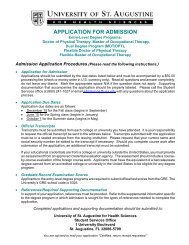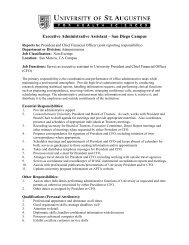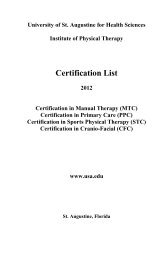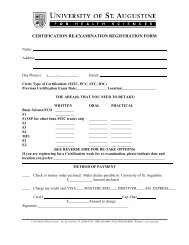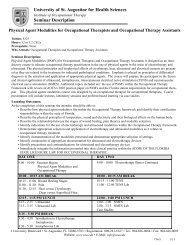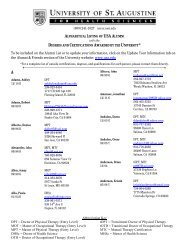CATALOG - University of St. Augustine for Health Sciences
CATALOG - University of St. Augustine for Health Sciences
CATALOG - University of St. Augustine for Health Sciences
Create successful ePaper yourself
Turn your PDF publications into a flip-book with our unique Google optimized e-Paper software.
scientific literature needed to guide evidence-based OT and PT clinical practice and perhaps to set someon the way to producing such scientific literature themselves.BSC 6301E – Ergonomics Hours: 2This online self-study course examines a variety <strong>of</strong> aspects <strong>of</strong> work related ergonomics. Participants willreview the history <strong>of</strong> ergonomics, ergonomic statistics, client centered framework <strong>of</strong> practice, the(Americans with disabilities act), universal design, posture, standing, sitting and computer work stationevaluation, occupational risks, cumulative trauma disorders/repetitive strain injuries/tendonitis, and lowback pain. Worker assessment and work hardening are reviewed be<strong>for</strong>e carrying out a worksiteassessment. Injury prevention, ergonomic equipment, ergonomic resources, and documentation are alsodiscussed. The course requires students to complete three projects: a posture evaluation, a computerworkstation evaluation and a work site evaluation. Bulletin board (BB) interaction is used to addresssubjects and respond to other students comments. Questions are addressed, papers written and projectswritten including a work site evaluation report letter.BSC 6301 – Ergonomics Hours: 2This online course examines a variety <strong>of</strong> aspects <strong>of</strong> work related ergonomics. Participants will review thehistory <strong>of</strong> ergonomics, ergonomic statistics, client centered framework <strong>of</strong> practice, the Americans withdisabilities act, universal design, posture, standing, sitting and computer work station evaluation,occupational risks, cumulative trauma disorders/repetitive strain injuries/tendonitis, and low back pain.Worker assessment and work hardening are reviewed be<strong>for</strong>e carrying out a worksite assessment. Injuryprevention, ergonomic equipment, ergonomic resources, and documentation are also discussed.The course requires students to complete two projects: a computer workstation evaluation and a work siteevaluation. Bulletin board (BB) interaction is used to address subjects and respond to other studentscomments. Questions are addressed, papers written and projects written including a work site evaluationreport letter.BSC 7001 - Foundations <strong>of</strong> Clinical Orthopaedics Hours: 2This is an online self-study course discussing the foundations <strong>of</strong> orthopaedics and manipulative therapy.The history and development <strong>of</strong> orthopaedics and specifically manual therapy are explored. Arthrologyand biomechanics are discussed, with special attention to tissue biomechanics and arthrokinematics.Emphasis is placed on spinal anatomy and movement. The <strong>University</strong>'s philosophy <strong>of</strong> examination,treatment, and pain management is introduced but attention is also given to other diagnostic classificationsystems. Classifications and indications <strong>for</strong> manipulation are reviewed. The course provides anintroduction to the evidence-in<strong>for</strong>med clinical practice paradigm teaching the student to combine varioussources <strong>of</strong> knowledge in the diagnosis, prognosis, and management <strong>of</strong> orthopaedic dysfunctions.Analysis, synthesis and evaluation will be demonstrated through a final portfolio <strong>of</strong> evidence basedresearch and a student’s critique <strong>of</strong> the current literature and design <strong>of</strong> a hypothetical study.BSC 7301 - Ergonomics Hours: 2This online course examines a variety <strong>of</strong> aspects <strong>of</strong> work related ergonomics. Participants will review thehistory <strong>of</strong> ergonomics, ergonomic statistics, client centered framework <strong>of</strong> practice, the Americans withdisabilities act, universal design, posture, standing, sitting and computer work station evaluation,occupational risks, cumulative trauma disorders/repetitive strain injuries/tendonitis, and low back pain.Worker assessment and work hardening are reviewed be<strong>for</strong>e carrying out a worksite assessment. Injuryprevention, ergonomic equipment, ergonomic resources, and documentation are also discussed.88



